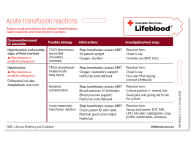Don’t have an account?
Select the donation type you’d like to make
As soon as you suspect a transfusion reaction:
- Stop the transfusion immediately and activate emergency procedures if required.
- Check and monitor the patient’s vital signs.
- Maintain intravenous (IV) access (do not flush the existing line and use a new IV line if required).
- Repeat all clerical and identity checks; ensure the right pack has been given to the right patient.
- Notify your Medical Officer and Transfusion Service Provider.
After the transfusion has been stopped (except for some types of mild reaction), you may be required by the Transfusion Service Provider to send freshly collected blood and urine samples along with the component pack and IV line. Follow the relevant organisational occupational health and safety policies at all times (e.g. do not transport IV lines with the insertion spike (sharp end) exposed).
Document the reaction in the patient’s medical record and complete an incident report if required by local policies.
For further information on the hospital management and investigation of suspected transfusion reactions refer to our 'Guidelines for hospital investigation of transfusion related sepsis' and 'Guidelines for the microbiology laboratory processing of blood components associated with transfusion reactions'.
Common adverse reactions to blood products and guide to appropriate clinical action
- Fever (≥38°C or rise ≥1°C) and/or chills, rigors
38°C to <39°C (no other symptoms) Possible etiology Action Investigation Febrile non-haemolytic transfusion reaction (FHNTR) STOP transfusion. Exclude serious adverse events. Give anti-pyretic.
Recommence cautiously if reaction subsides.Reaction form to transfusion laboratory. Further investigations not usually required. 38°C to <39°C (no other symptoms) Possible etiology Action Investigation Bacterial contamination or acute haemolytic transfusion reaction (AHTR)
May become a medical emergency
STOP transfusion.
Check patient ID with label. IV antibiotics if septic. Maintain good urine output.Sepsis work-up
Gram stain on blood product bag; blood
cultures on both patient and products.
Incompatible blood work-up
Group, screen and DAT on pre and
post-transfusion samples.
Haemolysis work-up
FBC, LDH, bilirubin, haptoglobin,
electrolytes, creatinine, urinalysis.
DIC work-up
Disseminated intravascular coagulation (DIC) may complicate a severe reaction – perform aPTT, PT, fibrinogen, D-Dimer (or FDP).- Rash or Urticaria (hives)
<2/3 body (no other symptoms) Possible etiology Action Investigation Minor allergic reactions STOP transfusion. Antihistamine.
Recommence if reaction subsides.None. >2/3 body (no other symptoms) Possible etiology Action Investigation Severe allergic reactions STOP transfusion. Antihistamine
+/- corticosteroid.None. With dyspnoea, airway obstruction, hypotension (this is a medical emergency) Possible etiology Action Investigation Anaphylaxis
(consider IgA deficiency)STOP transfusion.
Initiate basic life support.
Notify Lifeblood.Check haptoglobin, tryptase and IgA levels. Test for anti-IgA if IgA deficient. - Dyspnoea, shortness of breath, decreased oxygen saturation
With/without hypertension, tachycardia Possible etiology Action Investigation Transfusion associated circulatory overload (TACO) STOP transfusion. Assess chest X-ray for pulmonary oedema. Diuretics. Oxygen. Sit patient upright. Check BNP/N-terminal pro-BNP. Elevated levels are more common in TACO. With/without hypotension Possible etiology Action Investigation (Transfusion-related acute lung injury (TRALI)
May become a medical emergency
STOP transfusion.
Assess chest X-ray for infiltrates. Oxygen. Possible intubation, ventilation.
Notify LifebloodHLA and HNA typing and antibodies.
TRALI is a clinical diagnosis – investigations to exclude other reactions.
Check BNP/N-terminal pro-BNP. Normal levels are more common in TRALI.Bacterial contamination or acute haemolytic transfusion reaction (AHTR)
May become a medical emergency
STOP transfusion.
IV antibiotics if sepsis. Check patient ID with label. Maintain good urine output.
Notify LifebloodSepsis work-up
Gram stain on blood product bag; blood
cultures on both patient and products.
Incompatible blood work-up
Group, screen and DAT on pre and
post-transfusion samples.
Haemolysis work-up
FBC, LDH, bilirubin, haptoglobin,
electrolytes, creatinine, urinalysis.DIC work-up
Disseminated intravascular coagulation (DIC) may complicate a severe reaction – perform aPTT, PT, fibrinogen, D-Dimer (or FDP).
Note that this is a guide only. You must follow your hospital guidelines. Inform Lifeblood of any adverse reaction that may:
- relate to the quality of the product which will prompt Lifeblood to recall any associated products, e.g. transfusion transmissible infections, and TRALI; or
- require an alternative product to be requested e.g. washed red cells in patients with repeated anaphylactic reactions or IgA deficient products.
Clinical management must be tailored to the patient’s specific situation with the treating Medical Officer, Haematologist or Transfusion Service Provider.





